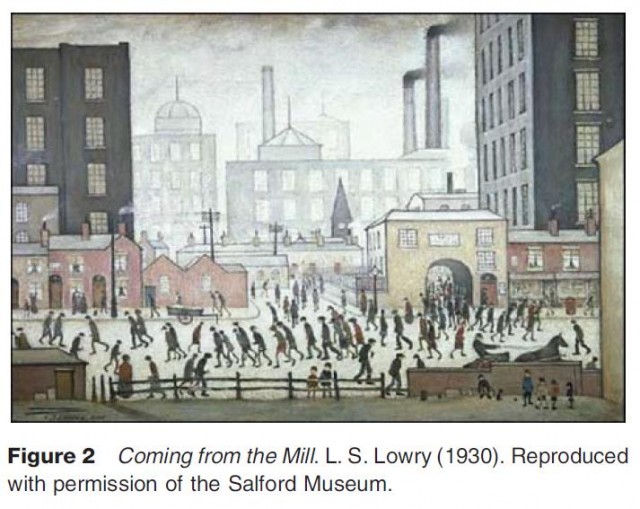Dislodging the Good Life, Disrupting the Rural
Industrialization proved to be the force that dislodged widespread pro urbanism. The good city for the good life morphed into Frederick Engels' Manchester, Henry Mayhew's London, and Upton Sinclair's Chicago, to name but a few representations of the industrial city as dirty, dark, crowded, anonymous, threatening to the weak, a jungle of brick, stone, and smoke. These representations were powerful in part because their audiences could see how far things had fallen, how much the industrial city had become the brutal opposite of the Athenian model. Gone was the city of intellectual discovery, artistic achievement, and political progress; in its place was L. S. Lowry's city of mighty factories sapping the life out of its faceless citizens (Figure 2). However, another factor was in place in conditioning anti-urbanism – it is impossible to trace the emergence of urban fears without considering 'pro rural' sentiment. Even though the Industrial Revolution transformed both urban and rural areas, the burgeoning system of capitalist accumulation in the nineteenth-century and its manifestation in intense urbanization was viewed with dismay by subscribers to traditional rural values (and it is important to note that, prior to the nineteenth-century, the vast majority of humans lived in rural areas), who saw the cities as places which encouraged a rejection of the basic human values behind the formation of an inherently moral existence.

For example, in the United States, a negative discourse of the city, which began with the pastoral musings of Thomas Jefferson and was furthered significantly by the transcendental contemplations of Ralph Waldo Emerson, grew stronger and became embedded in social life through powerful representations of urban malaise in late nineteenth and early twentieth century American literature, art, and social theory. Far from being celebrated as signs of industrial and economic progress, American cities were often viewed as dirty and diseaseridden arenas of degenerate, immoral, and corrupt behavior, the exact and unruly opposites of small town and rural America, and therefore places which middle class Americans would be wise to avoid for their own wellbeing. Raymond Williams' The Country and the City, a magisterial survey of the dialectical tensions between the country and the city in English literary representations, reminds us that the celebration of the rural in contrast to the castigation of the urban is not something confined to America, and through centuries of celebrated poetry, fiction, and philosophy this contrast has become extraordinarily pervasive, to the extent that it is ''one of the major forms in which we become conscious of a central part our experience and of the crises of our society.'' While Williams was careful to point out that the rural–urban contrasts were varied and sometimes inverted, for example, by Marx's observations of 'rural idiocy' and Baudelaire's city of 'feverish joys,' arguably the most powerful and lasting representations were those of rural tranquillity and urban hostility.
It was to a sizeable transatlantic body of anti-urban literary sentiment, deriving its power from the contrast to the pro urbanism of the past and pro ruralism of the age, that European social theorists such as Ferdinand Tonnies, Emile Durkheim, and Georg Simmel delivered their classic studies of the social and psychological effects of rampant urbanization. While it would be incorrect to describe their immensely influential and diverse perspectives on the changing patterns of social life in the city as somehow anti-urban, it would be equally incorrect to downplay the role they had in reinforcing anti-urban sentiment. Tonnies's elaborations of the impersonal and superficial human associations of an urban gessellschaft society, the opposite of community (gemeinschaft); Dur kheim's plaintive projections of the urban condition of 'anomie' and the deviant behavior which might accompany social isolation and confusion; and Simmel's accounts of individuals protecting themselves from the startling disruptions and discontinuities of the metropolitan milieu (leading to what he called 'psychic overload') all added fuel to the legacy of urban fear left by Emerson, Thoreau, and the transcendentalists in the US; and Thomas Hardy, William Wordsworth, George Gissing, and the Victorian writers in England. The ideas and attitudes of the sociologists may have differed, but their writings on what can happen to societies and individuals when cities expand did little to reverse the tide of anti-urban thinking which had penetrated the public imagination, even if the city was not always portrayed as the maelstrom of noise, suffering, and individual isolation like it was by those who came before them.
But why does this discourse of anti-urbanism matter, and why is it of interest to urban geographers? The answer is simple – if cities are repeatedly depicted as places devoid of compassion, care, and community, or worse, as dreadful, dark, and dangerous, then it becomes all too easy to treat them as places which must be avoided, or even places which must be tamed and seriously modified in the image of those possessing the appropriate powers. No where is this more apparent than in the United States. In 1962, Morton White and Lucia White wrote a landmark book entitled The Intellectual Versus the City, a remarkable survey of what they called the 'powerful tradition of anti-urbanism' emanating from the pens of several generations of leading American writers. They concluded that the collective criticism of urban life coming from distinguished American intellectuals such as, inter alia, Thoreau, Edgar Allan Poe, and Henry James, ''helps explain America's lethargy in confronting the massive problems of the contemporary city in a rational way.'' In 1962, White and White were not able to write with the benefit of insights from cultural geography, which have taught us to understand how landscapes are part of a system of social regulation and reproduction due to their dual properties of material form and discursive sign. However, in their book we begin to detect how anti-urban discourse becomes materialized into a particular 'way of seeing' the American city, and a way of treating it. A case study involving representations of New York serves to illustrate the power of the discourse of anti-urbanism.